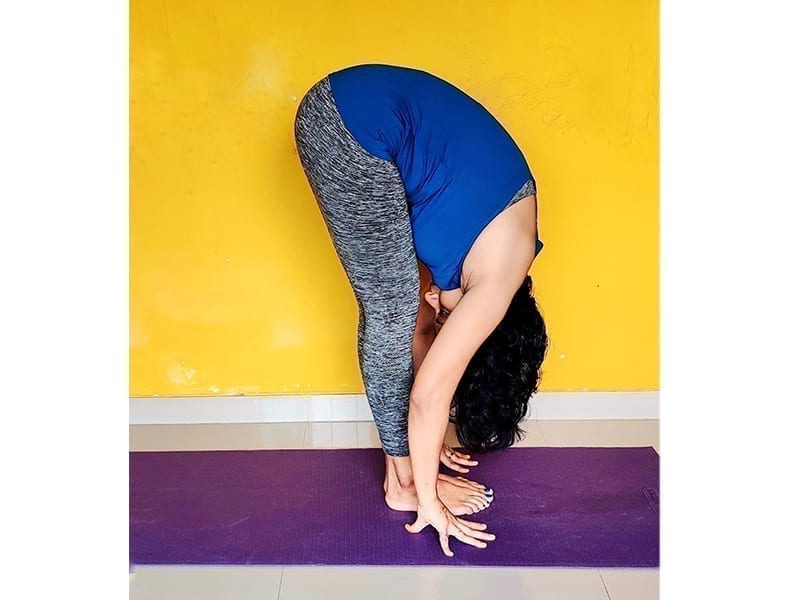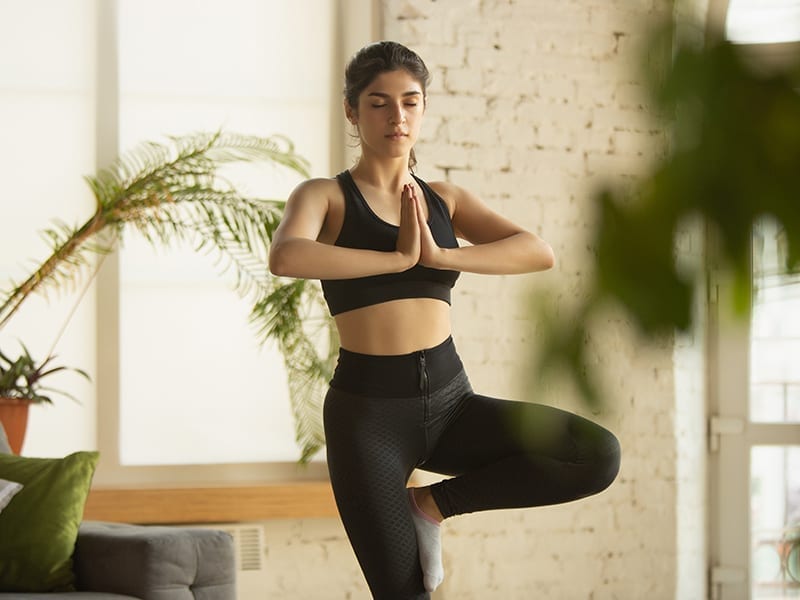Anxiety, panic attacks, depression, racing thoughts, and mood swings are symptoms of mental health issues. Yoga works as therapy as the poses incorporate postures and breathing practices which help calm your body and mind. Some studies show that practising Yoga activates the parasympathetic branch (relaxed, resting, or feeding) of the nervous system, replacing SNS (sympathetic nervous system) overdrive, or the flight-or-fight response, by balancing the nervous system.
Yoga increases self-awareness and helps you focus on the current moment. As a result, it can help individuals become aware of negative moods. The effects of yoga on mental health can also encourage self-worth and accept life challenges. It helps in lessening lethargy and agitation associated with depression and anxiety.
Benefits Of Yoga For Combatting Anxiety & Panic Attacks
1. Composes The Mind
As yoga is a combination of physical postures and breathing patterns, it helps in blood circulation and oxygen supply in the body and brain. It promotes positive energy flow.
2. Increases Focus
Yoga poses which mainly involve balancing help in keeping the body centred and mind focused.
3. Helps Manage Stress
A stressed mind faces major emotional highs and lows, which further hampers efficiency and negative emotions. Yoga therapy helps in calming the mind by balancing the hormones. Pranayama and meditation calm the mind and reduce stress.
4. Helps Build Self-Confidence
In our fast-paced lives, coping with an ever-changing world is becoming a challenge and affecting our mental health. A loss in confidence or self-esteem is often considered a cause for depression and anxiety. Yoga helps in balance and coordination – achieving physical balance can help achieve mental balance. It develops focus and concentration.
Yoga Asanas For Mental Health Rejuvenation
1. Uttanasana (Standing Forward Bend)

This asana is a boon for people suffering from anxiety.
Steps:
- Stand in Tadasana (stand straight with feet together) and arms beside the body.
- Breathing in, raise your hands overhead.
- Exhale and keep your spine straight, and bend forward and down towards the feet.
- Stay in the posture for 20-30 seconds and continue to breathe deeply.
- Try to go as deep as you can into this asana and try to touch your head to knee.
- Inhalemand, keeping your back straight, slowly raise your hands off the floor and come back to Tadasana.
Benefits:
- It helps maintain steady blood flow to the brain
- Relieves stress and mild depression
- Reduces fatigue and anxiety
2. Janu Sirsasana (Head To Knee Forward Bend)
This asana calms the mind.
Steps:
- Sit on the floor, with legs stretched straight in front.
- Bend your left knee and bring the sole of your left foot to your right inner thigh.
- Square your torso over your extended right leg. Begin to bring your torso down to your leg by tipping your pelvis forward so that the bend initiates from your hips instead of your lower back.
- Keep your right foot flexed while pressing the back of the right thigh down toward the floor.
- When you reach your maximum forward bending limit, you have a choice: You can maintain your straight spine and long neck in an active position, or you can relax your heart and head down toward the extended leg, allowing the spine to round. Do whichever one feels better.
- If your hands reach your foot, hold your foot. If not, you may hold onto your ankle or calf, or place your hands on the floor wherever they reach.
- On each inhale, extend the spine long. On each exhale, deepen the forward bend.
- Stay here for five to 10 breaths and then straighten both legs, shake them out, and repeat the pose on the other side.
Benefits:
- It gives a good stretch to your spine and abdominal organs
- Stimulates digestion and hence improves nutrient absorption, which is important for a healthy body and mind
3. Salamba Sarvangasana (Supported Shoulderstand)
Salamba Sarvangasana is a rejuvenating inverted pose.
Steps:
- Lie down on your back.
- Raise your legs slowly upward and bring it to 90° angle.
- Bring the legs towards the head by raising the buttocks up.
- Take your hands, place them on your back and slowly lift your legs up.
- Place the palms on your back for support.
- Your entire body should be in a straight line with your upper arm supporting your back.
- Hold the pose – begin with 10 seconds – breathe normally.
- Now slowly fold your leg from the knee.
- With the support of your hands, get your upper body down.
Benefits:
- It calms the nervous system by increasing blood flow to the brain, which in turn, helps lower stress and anxiety
- It helps improve digestion and sleep
4. Vajrasana (Thunderbolt Pose)
Vajrasana is a good pose for concentration and meditation.
Steps:
- Sit by kneeling on the floor. Keep your knees and big toes touching.
- Sit on your legs. The buttocks will rest between your heels and your thighs will rest on your calves.
- Put your hands on your thighs, touch your knees and sit comfortably in this posture.
- Keep your spine straight and inhale-exhale slowly at your own pace.
- Hold this posture for a few minutes or as long as you are comfortable.
Benefits:
- It helps in keeping the mind calm and stable
- Improves digestion and nutrient absorption
5. Vriksasana (Tree Pose)
It is an excellent exercise to help with your balance.
Steps:
- Stand in Tadasana (stand straight with feet together) and arms beside the body.
- Focus on a point in front. With inhalation slowly raise your hand and join the palms in namaste posture.
- In this position, continue deep breathing and stay here as long as you are comfortable.
Benefits:
- It is an excellent pose to improve neuromuscular coordination (trains the nerves and muscles to react and communicate)
- Improves alertness and concentration
6. Savasana (Corpse Pose)
This technique aims at relaxing your body and mind.
Steps:
- Lie on your back.
- Let your palms rest beside you while facing upwards.
- Close your eyes and then relax; your arms should be alongside your body and breathe naturally.
Benefits:
- It boosts your energy instantly
- Helps battle fatigue
7. Paschimottanasana (Two-Legged Forward Bend)
This particular asana is known to help digestion.
Steps:
- Sit upright, keeping your legs stretched and hands beside your body.
- Inhale and raise your hand up
- As you exhale, begin to bend forward, keeping your back straight.
- Touch your toe and try to touch your head to the knee.
Benefits:
- Helps tone the shoulders
- Stretches the lower back, hamstrings, and hips
- Calms brain activity, thereby relieving one from any form of stress or anxiety
- Massages and tones the abdominal and pelvic organs
8. Adho Mukha Svanasana (Downward-Facing Dog)
This pose leaves you energised and rejuvenates the body.
Steps:
- Come onto your fours. It should look like a tabletop posture.
- With Exhalation lift your hip up, straightening the knees and elbows, and form an inverted V-shape with the body.
- Give a good stretch across your shoulder and try to push your heels on the ground and feel the stretch on calf muscles.
- Continue to breathe normally and hold the posture for 30 seconds or till you are comfortable.
- With an exhalation, put your knees down and relax in Balasana.
Benefits:
- This pose is excellent for insomnia and fatigue
- It increases circulation to the brain and calms the mind
9. Setu Bandhasana (Bridge Pose)
The shoulder supported or simply bridge, also called Setu Bandhāsana, is an inverted back-bending asana in modern yoga and hatha yoga as an exercise.
Steps:
- Lie down in a supine position (on your back) and hands beside your body.
- Fold your knees and hold your ankle with your palms.
- The distance between the feet should be hip apart.
- With inhale raise your back up and push your abdomen out.
- Hold this pose for 30 seconds and continue breathing normally.
- With exhalation bring your back down and relax.
Benefits:
- It helps in alleviating stress and improves blood circulation
10. Marjariasana (Cat Stretch)
The cat pose mostly focuses on stretching the lower back.
Steps:
- Come onto your fours. Your wrist and shoulder must be inline and hip and knees as well. It should look like a tabletop posture.
- With an exhalation, draw your abdomen in and spine up (round your back out).
- Point the crown of your head to the floor. Don’t force your chin onto your chest.
- With an inhalation, look up and spine down. Repeat it a few times.
Benefits:
- This pose helps relieve stress
- Increases spinal flexibility and mobility
- Creates emotional balance
- The movement also stretches the muscles of the hips, upper back, and lungs

